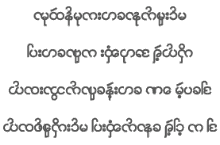Myanmar love poem
ကြည့်မှန်
မင်းမျက်နှာလေးကမှန်ထဲမှာ
ကိုယ်ရဲ့ အလှဆုံး ကဗျာလေးပါ
ဒါပေမဲ့ ခဏ လေးနဲ့ပျောက်သွားတယ်
ဒါ က ငါ့ရဲ့ နောက်ဆုံးပါ မင်းကိုချစ်တယ်

A transliteration
Kyanymhaan
Mainn myetnharlayy k mhaanhtellmhar
Korae aalhasone kabyaarlayypar
Darpaymae hkan layynaepyawwatswarrtaal
Dar k ngarrae noutsonepar mainnkohkyittaal

→ French poem ←
Burmese lady & myanmar
My Burmese lady, what else should I tell you? The day you will read it, my Burmese (Myanmar) love poem (အချစ်ကဗျာ) will print inside your eyes. From Naypyidaw to Rangoon, among the sacred cats of Burma, you look at yourself in the water of the rivers, where your tender image is reflected.
Please Re-read the end of my poem, it is matter of acting! So what are you waiting for?
Burmese is the official language of Burma and counts 30 million people, it is part of the Lolo-Burmese languages and comes from the central Burma dialect. The Burmese language is found in its present location since the year 800. There are about 350 languages of the Tibeto-Burman family, and Myanmar is the most spoken.
The Burmese script is close to mon which comes from Brahmi. The script since the 16th century has evolved, the language too. The Burmese writing is round, and dont separates a lot the words, I hope you will appreciate this translation, already for the beauty of the graphs.
Burmese literature
The first writing in Burmese dates back to 1113: it is the stele of Myazedi that relates historical events, the 1st works only date from the 15th century, before, the scholarly monks, wrote in Pali.
The majority of Burmese literary genres are written in verses, verses fixed for a very long time to four syllables. The oldest poem on a stone, dates from 1310, and it's assumed to be in the 2-3rd century, that begins the first elements of versification, that still govern Burmese poetry today.
The poets of the following period, 14-16th century, (Ava) have only one center of interest, the court.
The fifteenth sees the appearance of various poetic genres such as the egyin (to the glory of the monarch), the mawgun (panegyric in verse), the pyo (long poem on Buddha's life), the yadu (ode on love), and linga. The oldest preserved poem written on palm leaves is an egyin of 1491 composed by Adu Min Nyo.
In 1491 the Burmese poet Shin Thwe Nyo write a mawgun, and a bit later Uttamagyaw composes a linga. This last poet is the forerunner of the poet-monks like Rahtathara and Thilawuntha, fertile authors of pyo. These two poets, in a spirit of emulation, compose in all poetical genres. Two rival court poetesses write in the yadu genre: Ma Hpyu and Ma Nyo.
The golden age for the yadu and egyin is the Toungoo period (16th century), illustrated by Hlawgathondaunghmu and especially Nawadé the Great, poet, author of more than 300 yadu and the 1st to compose some pyo on a profane theme. But the master of the yadu is Natshinnaung. Poets Zeyayandameit and Shin Than Kho also excell in several genres of Burmese poetry. The poet Padethayaza is the precursor of the court theater.
If the 18-19th century, marks the decline of poetry, one can quote Thein Dakyaw Thu U Aw author of yadu evoking the Western romantic poets. Lethwethondara also shines in this genre. Nawadé the small composes some mawgun on traditional themes.
In the 18th century sung poetry and the yagan inspired by Hindu epics appear. The poem Yamayagan of the poet U To is the most famous. But it is mostly female court poets (Shi Min, Hlaing) who will sing poetry.
After the English conquest, poetry become more rare, but its themes expand, Pe Maung Tin, E Maung and Zawgyi are the poets who represent it. Later, the independence of 1948 will give rise to committed patriotic poems.